
Economics_-_New_Ways_of_Thinking
.pdf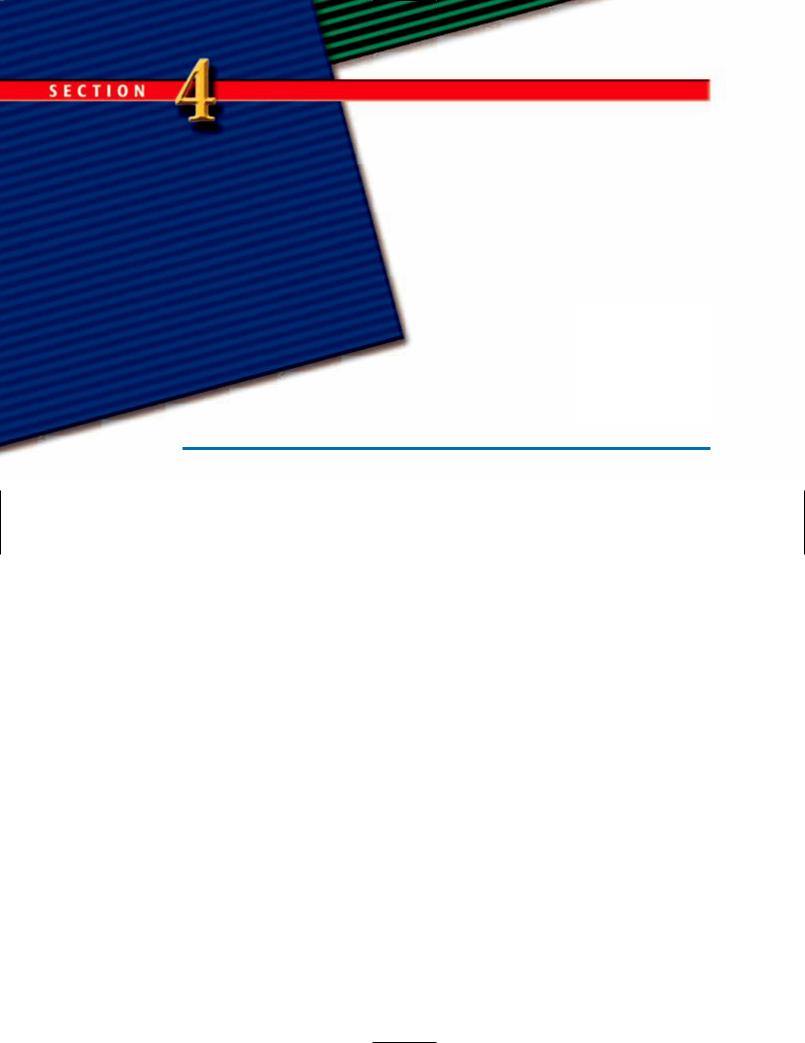
The Money
Creation Process
Focus Questions
What do total reserves equal?
What are required reserves? Excess reserves?
How do banks use checking accounts to increase the money supply?
What do banks do with excess reserves?
Knowing the reserve requirement, how can you calculate the maximum change in the money supply resulting from bank loans?
Key Terms
total reserves required reserves reserve requirement excess reserves
total reserves
The sum of a bank’s deposits in its reserve account at the Fed and its vault cash.
required reserves
The minimum amount of reserves a bank must hold against its deposits as mandated by the Fed.
reserve requirement
The regulation that requires a bank to keep a certain percentage of its deposits in its reserve account with the Fed or in its vault as vault cash.
Different Types of Reserves
Here you are going to learn how the money supply in the United States is increased (more money) and decreased (less money). Before you can understand the difference, it is important to know the different types of a bank’s reserves. The following points and definitions are crucial to an understanding of how the money supply rises and falls.
1.The previous section mentioned that each member bank has a reserve account, which is simply a checking account that a commercial bank has with its Federal Reserve district bank. If we take the dollar amount of a bank’s reserve account and add it to the cash the bank has in its vault (called, simply enough, vault cash), we have the bank’s total reserves.
Total reserves Deposits in the reserve account at the Fed Vault cash
 The president of bank A, a small commercial bank, notes that the bank
The president of bank A, a small commercial bank, notes that the bank
has $15 million in its (bank) vault. (In other words, if the bank were robbed right now, the most the thieves would get is $15 million.) The bank president also notes that the bank has $10 million in its reserve account at the Fed. If we add the vault cash of $15 million (the money in the vault) to the $10 million deposit in the reserve account, we get a total of $25 million. This dollar sum—$25 million—is the bank’s total reserves.
2.A bank’s total reserves can be divided into two types: required reserves and excess reserves. Required reserves are the amount of reserves a bank must hold against its checking account deposits, as ordered by the Fed. For example, suppose bank A holds checking account deposits (checkbook money) for its customers totaling $100 million. The Fed requires, through its reserve requirement, that bank A hold a percentage of this total amount in the form of reserves—that is, either as deposits in its reserve account at the Fed or as vault cash
274 Chapter 10 Money, Banking, and the Federal Reserve System
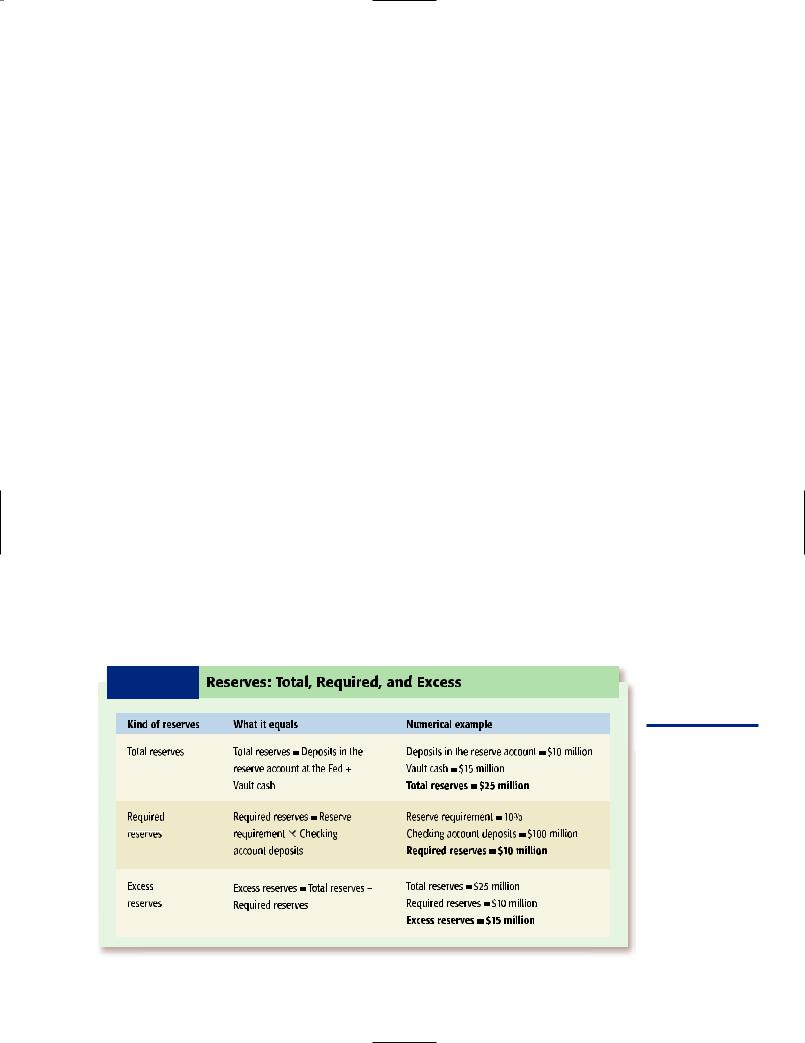
(because both of these are reserves). If the reserve requirement is 10 percent, bank A is required to hold 10 percent of $100 million, or $10 million, in the form of reserves. This $10 million is called required reserves.
Required reserves
Reserve requirement Checking account deposits
3.Excess reserves are the difference between total reserves and required reserves. For example, if total reserves equal $25 million and required reserves equal $10 million, then excess reserves would be $15 million. See Exhibit 10-5 for a review of these points.
4.Banks can make loans with their excess reserves. For example, if bank A has excess reserves of $15 million, it can make loans of $15 million.
(You may not realize it, but you just read a very short but very important section of this chapter. In this section you were introduced to four new terms—total reserves, required reserves, reserve requirement, and excess reserves. If you are not absolutely sure what each term refers to, you should go back and read this section again. These four terms will be used often in the discussion that follows. You don’t want to be in the thick of the discussion asking yourself, “What are required reserves again?”)
How Banks Increase the
Money Supply
Earlier we said that the money supply is the sum of three components: currency (coins and paper money), checking account deposits, and traveler’s checks. For example, $710 billion in currency, $619 billion in checking account deposits, and $7 billion in traveler’s checks mean that the money supply is $1,336 billion. You will recall that checking account deposits are sometimes referred to as demand deposits because a checking account contains funds that can be withdrawn not only by a check but also on demand.
Banks (such as your local bank down the street) are not allowed to print currency. Your bank cannot legally print a $10 bill. (No matter how hard you look, you are not going to find a money-printing machine in the bank.) However, banks can create checking account deposits (checkbook money), and if they do, they increase the money supply. The following discussion explains the process.
Creating Checking Account Deposits
To see how banks use checking account deposits to increase the money supply, let’s imagine a fictional character named Fred. (His name rhymes with Fed for a reason you will learn later.) Fred is somewhat of a magician: he can snap his fingers and create a $1,000 bill out of thin air. On Monday
excess reserves
Any reserves held beyond the required amount.
E X H I B I T 10-5 Reserves: Total, Required, and Excess
Kind of reserves
Total reserves
Required
reserves
Excess
reserves
What it equals
Total reserves = Deposits in the reserve account at the Fed + Vault cash
Required reserves = Reserve requirement Checking account deposits
Excess reserves = Total reserves
Required reserves
Numerical example
Deposits in the reserve account = $10 million Vault cash = $15 million
Total reserves = $25 million
Reserve requirement = 10%
Checking account deposits = $100 million
Required reserves = $10 million
Total reserves = $25 million
Required reserves = $10 million
Excess reserves = $15 million
A summary of the different types of reserves.
Section 4 The Money Creation Process 275

Follow this diagram and the explanation in the text to see how banks increase the money supply.
morning at 9:00, outside bank A, Fred snaps his fingers and creates a $1,000 bill. He immediately walks into the bank, opens up a checking account, and tells the banker that he wants the $1,000 deposited into his checking account. The banker gladly complies. Entry
(a) in Exhibit 10-6 shows this deposit.
Now what does the bank physically do with the $1,000 bill? It places it into its vault, which means the money found its way into vault cash, which is part of total reserves. (Total reserves Deposits in the reserve account at the Fed Vault cash.) Thus, if vault cash goes up by $1,000, total reserves increase by the same amount. (If you need to check back to the earlier equations to see this total, do it now.)
To keep things simple, let’s assume that bank A had no checking account deposits before Fred walked into the bank. Now it has $1,000. Also, let’s say that the Fed set the reserve requirement at 10 percent. What are bank A’s required reserves? Required reserves equal the reserve requirement multiplied by checking account deposits. Bank A’s $1,000
10 percent $100, which is the amount bank A has to keep in reserve form—either in its reserve account at the Fed or as vault cash. Look at entry (b) in Exhibit 10-6.
Currently, however, bank A has more than $100 in its vault; it has the $1,000 that Fred handed over to it. What, then, do its excess reserves equal? Because excess reserves equal total reserves minus required reserves, it follows that the bank’s excess reserves equal $900, the difference between $1,000 (total reserves) and $100 (required reserves), as in entry (c) in Exhibit 10-6.
What Does the Bank Do with Excess Reserves?
What does bank A do with its $900 in excess reserves? It creates new loans with the money. For example, suppose Alexi walks into bank A and asks for a $900 loan. The loan officer at the bank asks Alexi what she wants the money for. She tells the loan officer she wants a loan to buy a television set, and the loan officer grants her the loan.
E X H I B I T 10-6 The Banking System Creates Demand Deposits (Money)
This amount was created by Fred.
Bank |
New checking |
Required |
Excess reserves, new loans, |
|
account deposits |
reserves |
or new bank-created |
|
(new reserves) |
|
checking account deposits |
A |
$1,000 |
(a) |
$100 |
(b) |
$900 |
(c) |
B |
$900 |
(d) |
$90 |
(e) |
$810 |
(f) |
C |
|
$810 |
|
|
$81 |
|
|
|
|
|
|
$729 |
|
|
|
|
|
|
|
|
|
|
|
|
|
|
|
|
|
D |
|
$729 |
|
$72.90 |
$656.10 |
|||||||||
|
|
|
|
|
|
|
|
|
|
|
|
|
|
|
E |
|
|
|
|
|
|
|
|
|
|
|
|
|
|
|
|
|
|
|
|
|
This amount was |
|
|
|||||
|
|
|
|
|
|
|
||||||||
|
|
|
|
|
|
|
|
|
|
|
|
|
||
|
|
|
|
|
|
|
|
created by the banks. |
|
|
||||
Totals |
$10,000 |
$1,000 |
$9,000 |
Created |
Created by |
Created by Fred |
by Fred |
banking system |
and banking system |
$1,000 |
+ |
$9,000 |
= |
$10,000 |
276 Chapter 10 Money, Banking, and the Federal Reserve System
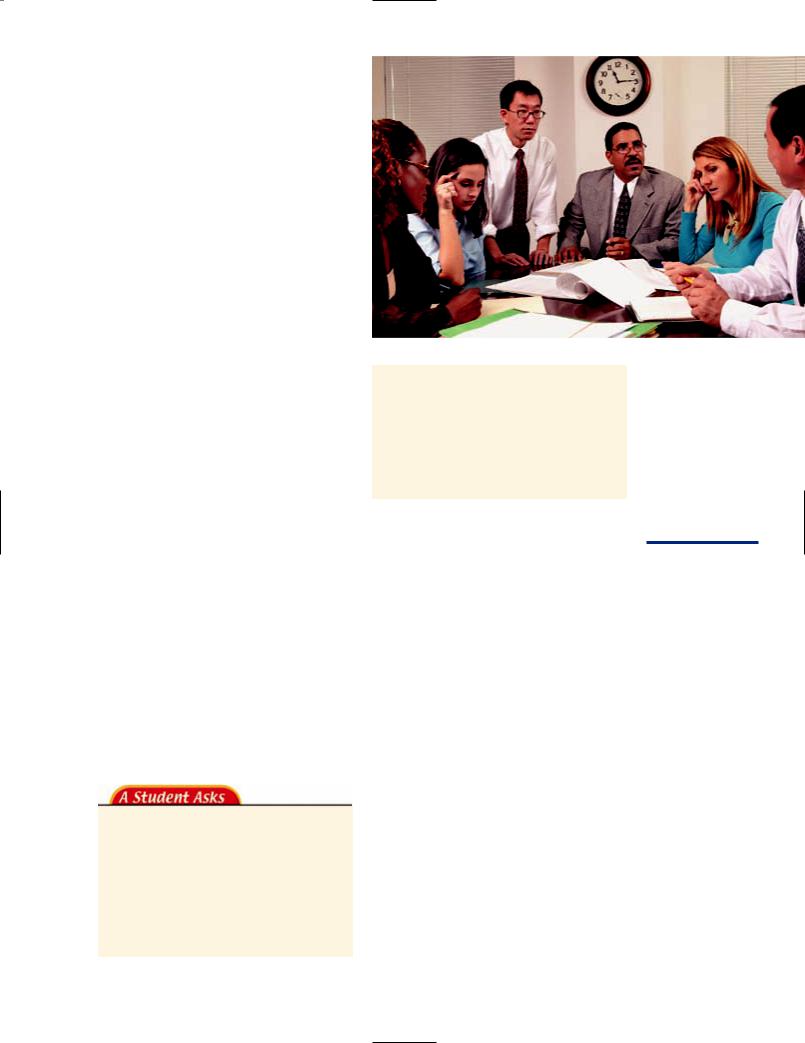
Some people may think that at this point the loan officer of the bank simply walks over to the bank’s vault, takes out $900 in currency, and hands it to Alexi. It does not happen this way. Instead, the loan officer opens up a checking account for Alexi at bank A and informs her that the balance in the account is $900. See entry (c) in Exhibit 10-6. In other words, banks give out loans in the form of checking account deposits. (This point is important to remember as we continue.)
What has bank A done by opening up a checking account (with a $900 balance) for Alexi? It has, in fact, increased the money supply by $900. Remember that the money supply consists of (1) currency, (2) checking account deposits, and (3) traveler’s checks. When bank A opens up a checking account (with a balance of $900) for Alexi, the dollar amount of currency has not changed, nor has the dollar amount of traveler’s checks. The only thing that has changed is the dollar amount of checking account deposits, or checkbook money. It is $900 higher, so the money supply is $900 higher, too.
At this point you might ask,“But isn’t the $900 Alexi receives from the bank part of the money that Fred deposited in the bank?” To say that Fred does not have the $1,000 anymore, but Alexi has $900 of it, is not exactly correct. Fred does not have the $1,000 in currency anymore, but he does still have $1,000. In other words, he doesn’t have the $1,000 on him, in his wallet. It is now in the bank vault. He does have a checking account with a balance of $1,000. Alexi now has $900 in her checking account as well, an additional $900, created by the bank, that did not exist before.
QUESTION: Does the bank have to create a loan with its excess reserves?
ANSWER: No, it does not have to create a loan with its excess reserves, but lending money is what banks do. That is how banks generate income. A bank is a business like any other business, trying
to make a profit. Banks extend loans to customers to earn income in much the same way that a farmer grows and sells corn to earn an income. If a bank were to hold on to its excess reserves, it would be ignoring an opportunity to earn income.
What Happens After a Loan Is
Granted?
So far, Alexi is given a loan in the form of a $900 balance in a new checking account. She now goes to a retail store and buys a $900 television set. She pays for the set by writing out a check for $900 drawn on bank A. She hands the check to the owner of the store, Roberto.
At the end of the business day, Roberto takes the check to bank B. For simplicity’s sake, we assume that checking account deposits in bank B equal zero. Roberto, however, changes this situation by depositing the $900 into his checking account. See entry
(d) in Exhibit 10-6.
At this point, the check-clearing process (described earlier) kicks in. Bank B sends the check to its Federal Reserve bank, which increases the balance in bank B’s reserve account by $900. At the same time, the Federal Reserve bank decreases the funds in bank A’s reserve account by $900. Once the Federal Reserve bank increases the balance in bank B’s reserve account, total reserves for
Bank employees must decide what to do with the bank’s excess reserves. The bank’s success depends on these people being able to make good loans with the excess reserves.
Section 4 The Money Creation Process 277
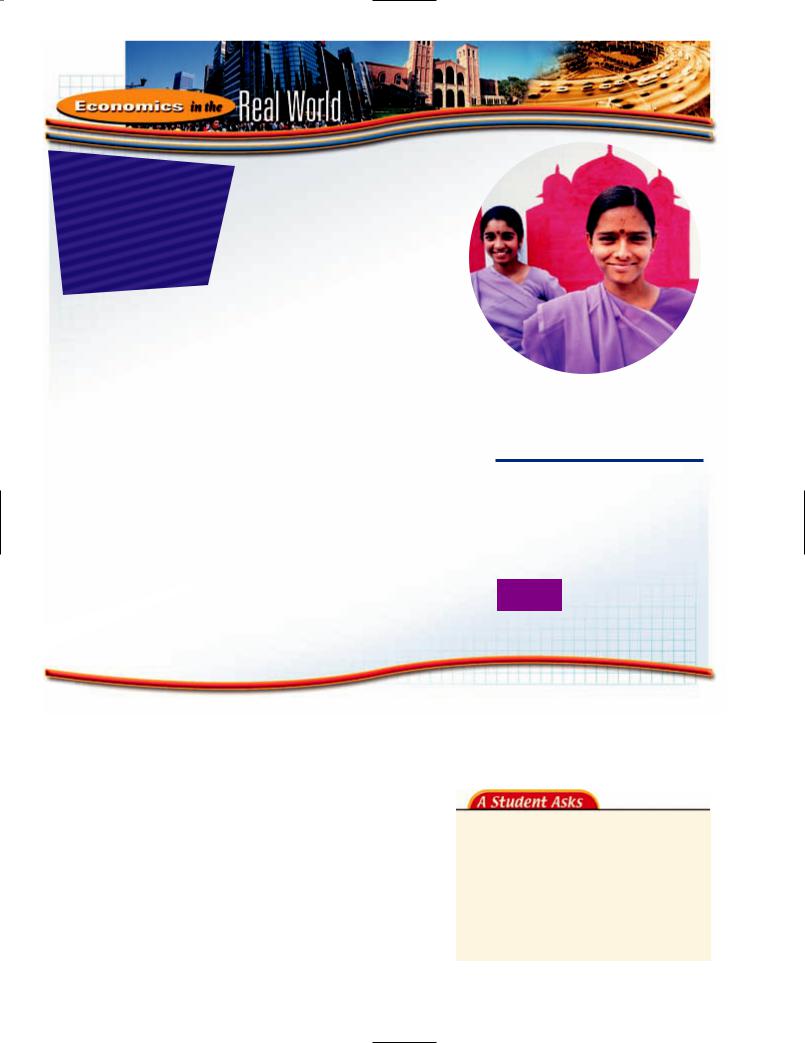
How Is the?
English
Language
Like Money?
Money emerged (or evolved) out of a barter
economy. In a barter economy many goods were traded. One good, among all goods, was more widely accepted for purposes of exchange. People started holding this good to reduce their transaction costs. Soon, everyone was accepting this good for purposes of exchange and thus it became money.
Have you ever thought that the same process might be at work when it comes to various lan-
guages? Many languages are spoken in the world today. A few languages are widely spoken, such as Spanish and English. Increasingly, though, one language is becoming the language
that you hear spoken all over the world, and that language is English.
You can see English on posters in India, Japan, China, and many other countries. You can hear English in pop songs sung in Tokyo, Hong Kong, Mexico City, and Moscow. English is the language of 98 percent of German research physicists. It is the official language of the European Central Bank, even though the bank is
in Frankfurt, Germany. English is found in official documents in
Phnom Penh, Cambodia. Alcatel, a French telecommunications
company, uses English as its internal language.
In a barter economy, we know that the more people who accept a particular good in exchange, the more other people will accept that good in exchange. Might the same be the case of a language? Might it be the case that the more people (as a percentage of the world’s population) who speak English, the more people will want to learn and
How might the fact that these young ladies in Agra, India, speak English lower transaction costs for you?
speak English? Just as money lowers the transaction costs of making exchanges, English might lower the transaction costs of communicating.
Is the world evolving toward one universal
language and is that language English? Explain your answer.
bank B rise by $900. (Total reserves Deposits in the reserve account at the Fed Vault cash.) Again, see entry (d) in Exhibit 10-6.
What happens to the checking account deposits at bank B? They rise to $900, too. Bank B is required to keep a percentage of the checking deposits in reserve form. If the reserve requirement is 10 percent, then $90 has to be maintained as required reserves as in entry (e) in Exhibit 10-6. The remainder, or excess reserves ($810), can be used by bank B to extend new loans or create new checking account deposits (which are money), as in entry (f) in Exhibit 10-6. The
story continues in the same way with other banks (banks C, D, E, and so on).
QUESTION: In the story so far, bank A creates a loan, then bank B creates a loan, then bank C creates a loan and so on. Does this process ever stop?
ANSWER: Yes, it stops when the dollar amounts that a bank can lend out become tiny. For example, notice that
278 Chapter 10 Money, Banking, and the Federal Reserve System
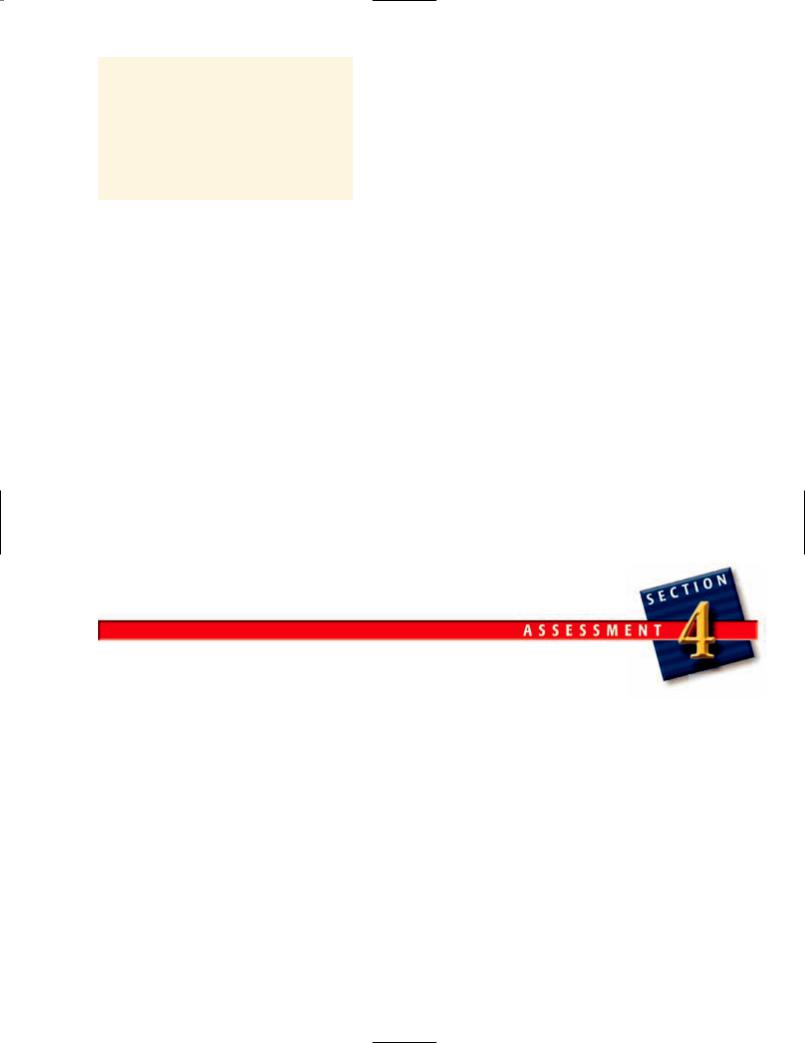
bank A created a loan of $900, but bank B created a loan of only $810, and bank C created a still smaller loan of $729. In other words, the loans become smaller and smaller. At some point, the dollar amount becomes so small that it doesn’t make sense to create a loan.
How Much Money Was Created?
So far, bank A created $900 in new loans or checking account deposits, and bank B created $810 in new loans or checking account deposits. If we continue by bringing in banks C, D, E, and so on, we will find that all banks together—that is, the entire banking system—create $9,000 in new loans or checking account deposits (money) as a result of Fred’s deposit. This dollar amount is boxed in Exhibit 10-6. This $9,000 is new money—money that did not exist before Fred snapped his fingers, created $1,000 out of thin air, and then deposited it into a checking account in bank A.
The facts can be summarized as follows:
1.Fred created $1,000 in new paper currency (money) out of thin air.
2.After Fred deposited the $1,000 in bank
$9,000 in additional checking account deposits (money).
Thus, Fred and the banking system together created $10,000 in new money. Fred created $1,000 in currency, and the banking system created $9,000 in checking account deposits. Together, they increased the money supply by $10,000.
You can use the following simple formula to find the (maximum) change in the money supply ($10,000) brought about in the example:
Change in money supply 1/Reserve requirement Change in reserves of first bank
In the example, the reserve requirement was set at 10 percent (0.10). The reserves of bank A, the first bank to receive the injection of funds, changed by $1,000. Put the data into the formula:
Change in the money supply 1/0.10 $1,000 $10,000
The idea here is that $1,000 created by Fred ends up increasing the money supply by a specific multiple (in this example, the
Defining Terms
1.Define:
a.total reserves
b.required reserves
c.reserve requirement
d.excess reserves
Reviewing Facts and
Concepts
2.Fred creates $2,000 in currency with the snap of his fingers and deposits it in bank A. The reserve requirement is 10 percent. By how much does the money supply increase?
3.Bank A has checking account deposits of $20
million, the reserve requirement is 10 percent, vault cash equals $2 million, and deposits in the reserve account at the Fed equal $1 million. What do required reserves equal? What do excess reserves equal?
Critical Thinking
4.The numerical examples in this section always had banks creating loans (new checking account deposits) equal to the amount of excess reserves they held. For example, if
bank A had $900 in excess reserves, it would create new loans equal to $900, not something less. In reality, banks may not lend out every dollar of their excess reserves, but they usually come close. Why would a bank want to lend out nearly all (if not all) of its excess reserves?
Applying Economic
Concepts
5.Is a $100 check money? Explain.
Section 4 The Money Creation Process 279
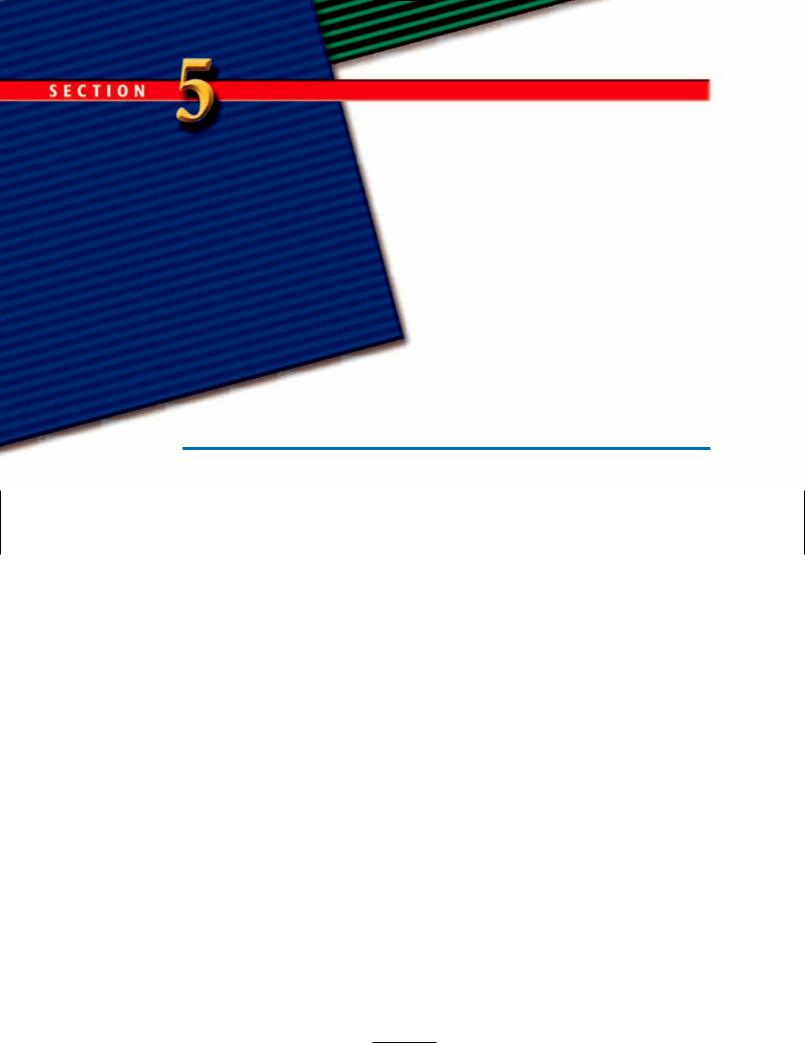
Fed Tools for Changing the Money Supply
Focus Questions
How does a change in the reserve requirement change the money supply?
How does an open market operation change the money supply?
How does a change in the discount rate change the money supply?
Key Terms
open market operations federal funds rate discount rate
Changing the Reserve
Requirement
Think of the Fed as having three “buttons” to push. Every time it pushes one of the three buttons, it either raises or lowers the money supply. The first button is the reserve requirement button. To understand how a change in it can change the money supply, let’s consider three cases. In each case, the money supply is initially zero, and $1,000 is created out of thin air. The difference in the three cases is the reserve requirement, which is 5 percent in the first case, 10 percent in the second, and 20 percent in the third. Let’s calculate the change in the money supply in each of the three cases. For these calculations we will use the formula you learned in the last section:
Change in money supply 1/Reserve requirement Change in reserves
of first bank
Case 1: (Reserve requirement 5%); Change in money supply 1/0.05 $1,000 $20,000
Case 2: (Reserve requirement 10%); Change in money supply 1/0.10 $1,000 $10,000
Case 3: (Reserve requirement = 20%); Change in money supply 1/0.20 $1,000 $5,000
Note that the money supply is the largest ($20,000) when the reserve requirement is 5 percent. The money supply is the smallest ($5,000) when the reserve requirement is 20 percent. You can see that the smaller the reserve requirement, the bigger the change in the money supply. So, ask yourself what happens to the money supply if the reserve requirement is lowered? Obviously, the money supply must rise. What happens to the money supply if the reserve requirement is raised? Obviously, the money supply must fall.
Thus, the Fed can increase or decrease the money supply by changing the reserve requirement. If the Fed decreases the reserve requirement, the money supply increases; if it increases the reserve requirement, the money supply decreases.
Lower reserve requirement → Money supply rises Raise reserve requirement → Money supply falls
280 Chapter 10 Money, Banking, and the Federal Reserve System
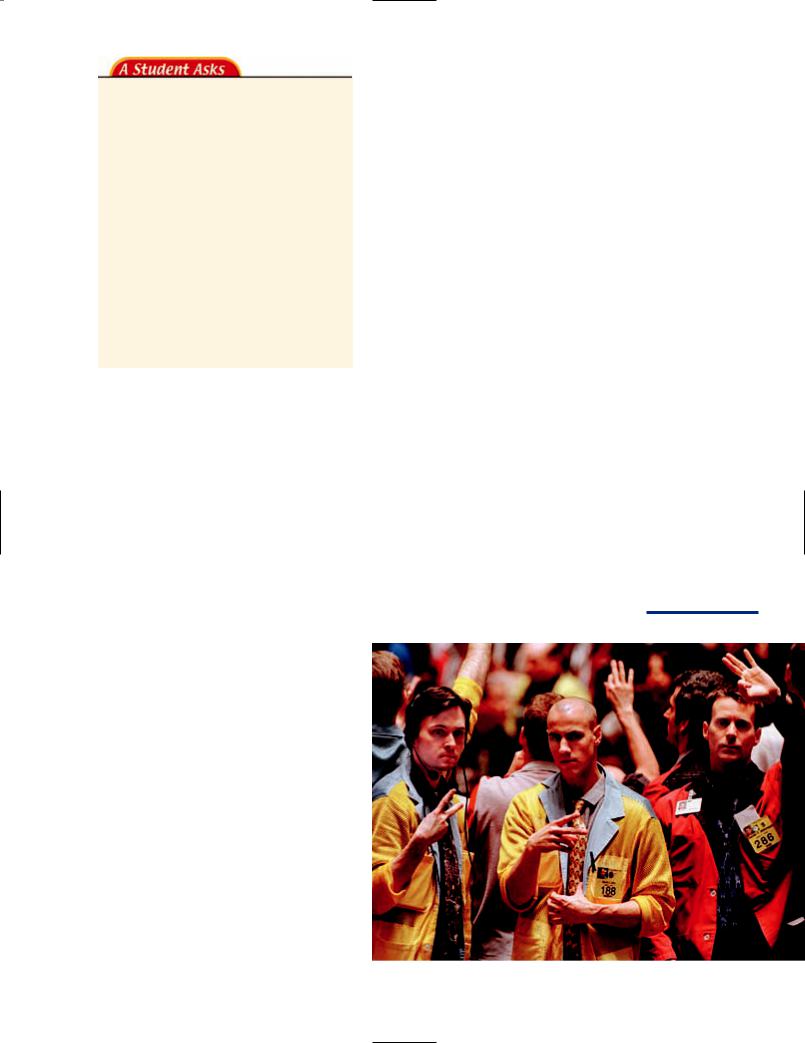
QUESTION: Why would the Fed want to increase or decrease the money supply? Why not simply leave the money supply alone?
ANSWER: You are asking a question about monetary policy, a topic we will discuss more fully in a later chapter. For now, though, let us just say that the Fed may increase or decrease the money supply to deal with some economic problem. For example, if businesses are not doing well, and the unemployment rate is rising, the Fed might want to increase the money supply to stimulate consumer spending.
Open Market Operations
The second button the Fed can “push” to change the money supply is the open market operations button. Remember that earlier we mentioned an important committee in the Federal Reserve System, the Federal Open Market Committee (FOMC). This committee of 12 members conducts open market operations. Open market operations are simply the buying and selling of government securities by the Fed. Before we discuss open market operations in detail, we need to provide some background information that relates to government securities and the U.S. Treasury.
The U.S. Treasury is an agency of the U.S. government. The Treasury’s job is to collect the taxes and borrow the money needed to run the government. Suppose the U.S. Congress decides to spend $1,800 billion on various federal government programs. The U.S. Treasury has to pay the bills. It notices that it collected only $1,700 billion in taxes, which is $100 billion less than Congress wants to spend. It is the Treasury’s job to borrow the $100 billion from the public. To borrow this money, the Treasury issues or sells government (or Treasury) securities to members of the public. A government security is no more than a piece of paper promising to pay a certain dollar amount of money in the future; think of it as an IOU statement.
The Fed (which is different from the Treasury) may buy government securities from any member of the public or sell them. When the Fed buys a government security, it is said to be conducting an open market purchase. When it sells a government security, it is said to be conducting an open market sale. These operations affect the money supply.
Open Market Purchases
Let’s say that you currently own a government security, which the Fed offers to purchase from you for $10,000. You agree to sell your security to the Fed. You hand it over, and in return you receive a check made out to you for $10,000.
It is important to realize where the Fed gets this $10,000. It gets the money “out of thin air.” Remember Fred, who had the ability to snap his fingers and create a $1,000 bill out of thin air? Obviously, no such person has this power. The Fed, however, does have this power—it can create money “out of thin air.”
How does the Fed create money out of thin air? Think about the answer in this way: You have a checking account, and the Fed has a checking account. Each account has a certain balance (amount in the account). The Fed can take a pencil and increase the balance in its account at will—legally. You, on the other hand, cannot, nor can anyone
open market operations
Buying and selling of government securities by the Fed.
These clerks at the Chicago Board of Trade are buying and selling U.S. Treasury bonds. Why does the U.S. Treasury issue bonds?
Section 5 Fed Tools for Changing the Money Supply 281
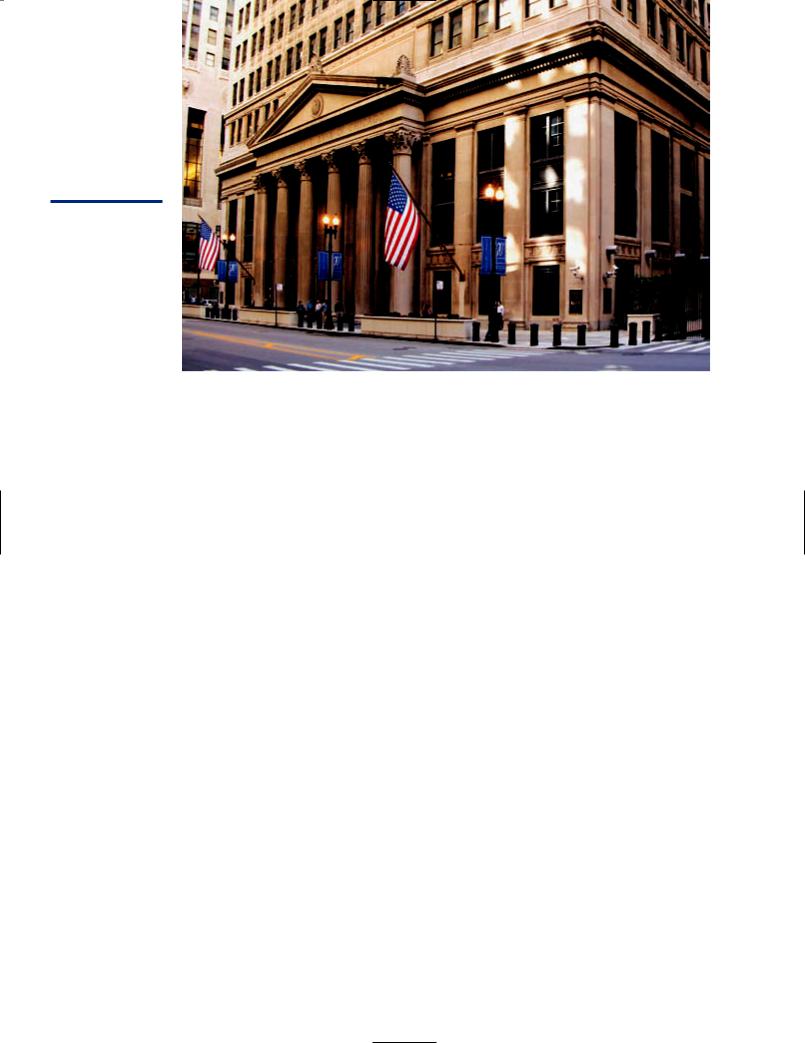
The Federal
Reserve Bank of Chicago. What are some of the functions this bank performs for the commercial banks in its district?
federal funds rate
The interest rate one bank charges another for a loan.
discount rate
The interest rate the Fed charges a bank for a loan.
else. If you decide to pencil in a new balance and then write a check for an amount you don’t have in your checking account, your check bounces and you pay the bank a penalty charge. Fed checks do not bounce. The Fed can, and does, create money at will “out of thin air.”
Let’s return to the example of an open market purchase. Once you have the $10,000 check from the Fed, you take it to your local bank and deposit it in your checking account. The total dollar amount of checking account deposits in the economy is now $10,000 more than before the Fed purchased your government security. Because no other component of the money supply (not currency or traveler’s checks) is less, the overall money supply has increased.
Open market purchase → Money supply rises
Open Market Sales
Suppose the Fed has a government security that it offers to sell you for $10,000. You agree to buy the security. You write out a check to the Fed for $10,000 and give it to the Fed. The Fed, in return, turns the government security over to you. Next, the check is cleared, and a sum of $10,000 is removed from your account in your bank and transferred to the Fed. Once this sum is in the Fed’s possession, it is removed
from the economy altogether. It is as if it disappears from the face of the earth. As you might have guessed, the Fed also has the power to make money disappear into thin air.
The total dollar amount of checking account deposits is less than before the Fed sold you a government security. An open market sale reduces the money supply.
Open market sale → Money supply falls
Changing the Discount Rate
The third button the Fed can push to change the money supply is the discount rate button. Suppose bank A wants to borrow $1 million. It could borrow this dollar amount from another bank (say, bank B), or it could borrow the money from the Fed. If bank A borrows the money from bank B, bank B will charge an interest rate for the $1 million loan. The interest rate charged by bank B is called the federal funds rate. If bank A borrows the $1 million from the Fed, the Fed will charge an interest rate, called either the primary credit rate or the discount rate.
Whether bank A borrows from bank B or from the Fed depends on the relationship between the federal funds rate and the discount rate. If the federal funds rate is lower than the discount rate, bank A will borrow
282 Chapter 10 Money, Banking, and the Federal Reserve System
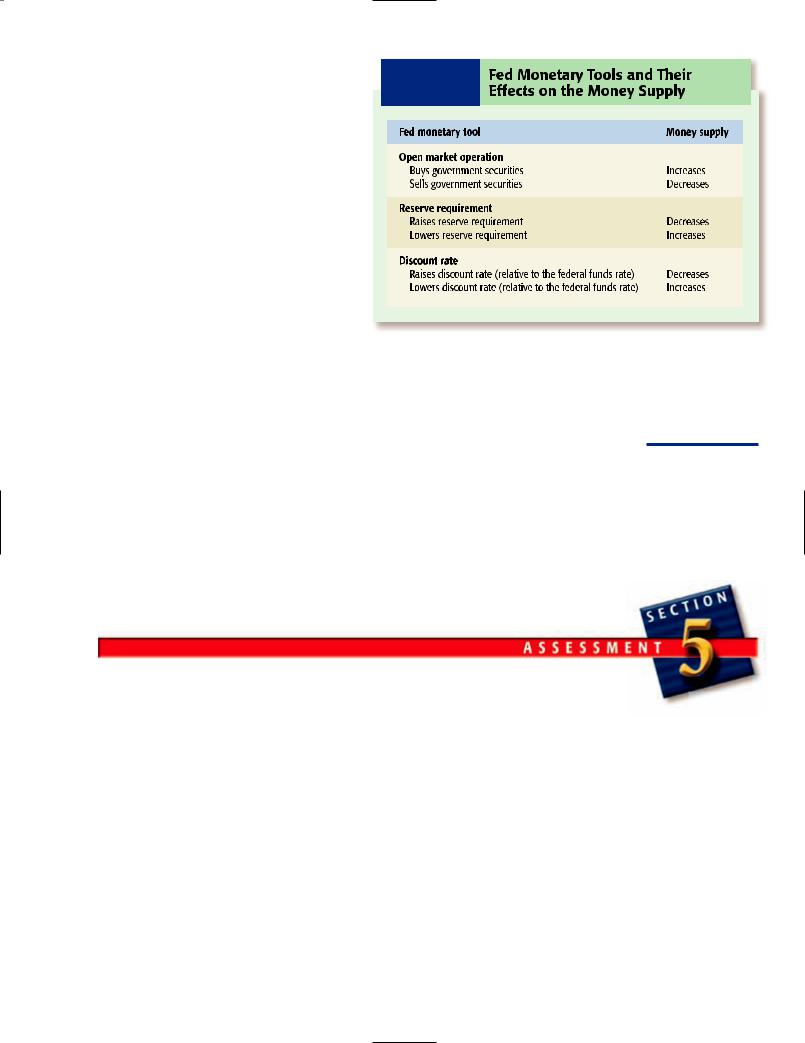
from bank B instead of from the Fed. (Why pay a higher interest rate if you don’t have to?) If, however, the discount rate is lower than the federal funds rate, bank A will probably borrow from the Fed.
Whether bank A borrows from bank B or from the Fed has important consequences. If bank A borrows from bank B, no new money enters the economy. Bank B simply has $1 million less, and bank A has $1 million more; the total hasn’t changed.
If, however, bank A borrows from the Fed, the Fed creates new money in the process of granting the loan. Here is how it works: the bank asks for a loan, and the Fed grants it by depositing the funds (created out of thin air) into the reserve account of the bank. For example, suppose the bank has $4 million in its reserve account when it asks the Fed for a $1 million loan. The Fed simply changes the reserve account balance to $5 million.
If the Fed lowers its discount rate so that it’s lower than the federal funds rate, and if banks then borrow from the Fed, the money supply will increase.
Lower the discount rate → Money supply rises
If the Fed raises its discount rate so that
E X H I B I T 10-7 Fed Monetary Tools and Their Effects on the Money Supply
Fed monetary tool
Open market operation
Buys government securities
Sells government securities
Reserve requirement
Raises reserve requirement
Lowers reserve requirement
Discount rate
Raises discount rate (relative to the federal funds rate)
Lowers discount rate (relative to the federal funds rate)
rather than from the Fed. At some point, though, the banks must repay the funds they borrowed from the Fed in the past (say, funds they borrowed many months ago), when the discount rate was lower. When the banks repay these loans, money is removed from the economy, and the money supply drops. We conclude that if the Fed raises its discount rate relative to the federal funds rate, the money supply will eventually fall.
Money supply
Increases
Decreases
Decreases
Increases
Decreases
Increases
This table summarizes the ways in which the Fed can change the money supply.
Raise the discount rate → Money supply falls
Defining Terms
1.Define:
a.discount rate
b.federal funds rate
c.open market operation
Reviewing Facts and
Concepts
2.The Fed wants to increase the money supply.
a.What can it do to the reserve requirement?
b.What type of open market operation can it conduct?
c.What can it do to the discount rate?
3.The Fed conducts an open market sale. Does the money for which it sells the government securities stay in the economy? Explain your answer.
Critical Thinking
4.When the Fed conducts an open market purchase, it buys government securities. As a result, the money supply rises. Could the Fed raise the money supply by buying something other than government securities?
For example, suppose the Fed were to buy apples instead of government securities. Would apple purchases (by the Fed) raise the money supply? Explain your answer.
Applying Economic
Concepts
5.If the Fed wants the money supply to rise by a ridiculously high percentage—say, 1 million percent—could it
accomplish this objective? Explain your answer.
Section 5 Fed Tools for Changing the Money Supply 283
